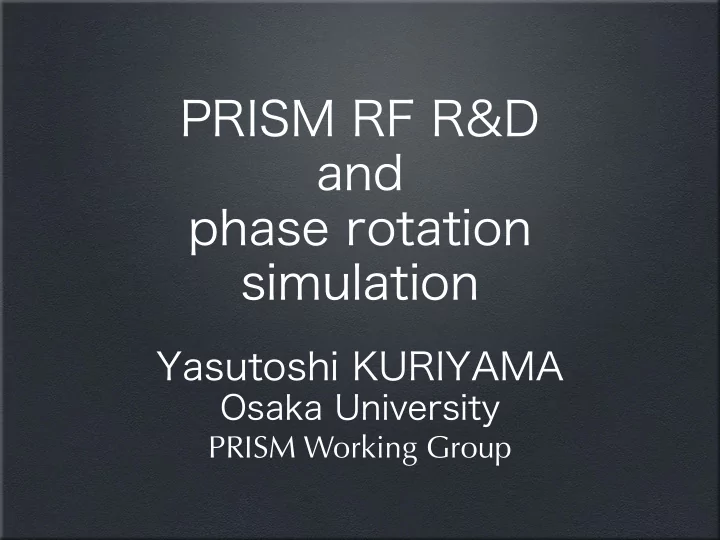

PRISM RF R&D and phase rotation simulation Yasutoshi KURIYAMA Osaka University PRISM Working Group
Contents • Introduction of RF System • Required SPEC. • Design • Amplifier t est result • Introduction of New RF Cavity • Phase Rotation Simulation • Summary
Phase Rotation in RF Field Energy time time Energy decelerate accelerate Requirements of PRISM RF • Ultra High Field Gradient 150kV/m ~ 200kV/m • Compact Cavity • High Gap Voltage
1.7m 3.5cm 1m PRISM MA core PRISM RF System Design • 8 sections in PRISM-FFAG ring • Cavity • Length: 1.75m • Shunt Impedance: 0.9k Ω/gap • 5 gaps /cavity 1.7m • 6 magnetic alloy cores /gap • 2 tetrode tubes /gap (push-pull) • RF frequency: ~5MHz • Duty < 0.1% • Air cooling
Gap Voltage pk-pk [kV] 20 Time 17:30 16:18 15:06 13:54 12:42 11:30 80 70 60 50 40 30 10 0 Amplifire Endurance Test Amp. & Test Cavity (Design Goal) (1gap, shunt Impedance 700Ω) RF Amplifier Test • Test RF system consists of • RF Amp. • PS. • Test Cavity • Achieved 43 kV gap voltage • Endurance Test • Repetition :100Hz • Burst length : 30μsec • Over 6 hours
2cm Gap 1m 1.8m Side View 33cm PRISM RF Cavity • 1 gap, Length 33cm, 6 MA cores, 2cm gap
5 P 2 4 3 2 1 Sawtooth RF P 2 = 1.21 Δ Σ 6 Δ Phase Rotation Simulation Simulation condition !"#$ • Injected muon 40 20 0 • 10m TOF -20 -40 -100 -50 0 50 100 !%&'($ • ±20% momentum spread � p/p(%) 20 15 • FFAG ring 10 5 • w/ TOSCA Magnet Field 0 • RF -5 -10 • 8 sections * 5 gaps = 40 gaps -15 -20 • 45 kV/gap (Total 1,800 kV) -100 0 100 • Parameter Search for Minimum Σ time(nsec) Sawtooth RF is good!
Phase Rotation Simulation Σ P 2 = 1.67 Δ P 2 = 9.87 Δ Σ Σ P 2 = 17.6 Δ 40 40 40 30 30 30 20 20 20 10 10 10 0 0 0 -10 -10 -10 -20 -20 -20 -30 -30 -30 -40 -40 -40 -50 -100 -50 0 50 100 -100 -50 0 50 100 -100 -50 0 50 100 � p/p(%) 20 20 20 15 15 15 10 10 10 5 5 5 0 0 0 -5 -5 -5 -10 -10 -10 -15 -15 -15 -20 -20 -20 -100 0 100 -100 0 100 -100 0 100 time(nsec) time(nsec) time(nsec) faster phase-rotation slower phase-rotation might be best larger momentum spread narrower momentum spread
Input RF changing in turn ΣΔ P 2 =1.08@5turns • Motivation � p/p(%) 20 in case of Normal RF We need ... 15 ΣΔ P 2 =1.67@6turns 10 • Fast phase rotation 5 • Reduce a number of Cavity 0 -5 Input RF is -10 -15 -20 -100 0 100 time(nsec) V 1 sin((2 π /T)(t-F 1 ))+ V 2 sin((2 π /1.9T)(t-F 2 ))+ V 3 sin((2 π /2.1T)(t-F 3 ))
Cavity in 7 straight sections ΣΔ P 2 =4.72@6turns • We consider a ring � p/p(%) 20 design, which has 3 15 10 kickers. 5 • It means RF cavity will be 0 installed in 7 straight -5 sections. -10 -15 -20 Now searching -100 0 100 time(nsec)
Summary scheduled in this spring • RF amplifier test has finished • PRISM cavity has been made • Phase rotation simulation study has started • ±20% Momentum Acceptance • ±2% Momentum Spread after 5 turns using changing RF • Complete RF system test has been
END
(2)パイオン崩壊 (1)パイオン捕獲部 -Search for μe conversion in a muonic atom- (4)検出器部 陽子ビーム ミューオン停止標的 位相空間回転部 (3)ミューオン ミューオン生成部 PRISM • PRISM = Phase Rotated Intense Slow Muon source (1)Pion Capture • 10 11~12 muon/sec PRISM Phase Rotated Intense Slow Moun source Proton Beam PRIME PRISM Muon to Electron conversion experiment (2)Transport pion & • pion contamination: <10 -18 FFAG-Magnet muon production Kicker Magnet for Extraction • momentum spread: < ±2% RF Cavity (3)PRISM- Kicker Magnet • by phase rotation for Injection FFAG ring (4)Detector part RF AMP • momentum: ~68MeV/c RF PS 5 m 5m
Recommend
More recommend